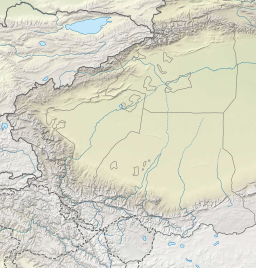Tso Tang
| Tso Tang | |
|---|---|
| མཚོ་ཐང (Standard Tibetan) | |
 Sentinel-2 image (2022) | |
| Location | Aksai Chin, Hotan Prefecture, Xinjiang |
| Coordinates | 34°53′42.96″N 79°21′29.94″E / 34.8952667°N 79.3583167°E |
| Surface area | 38 km2 (15 sq mi) |
| Surface elevation | 4,800 m (15,700 ft) |
| Frozen | Winter |
 | |
| Tso Tang | |||||||
|---|---|---|---|---|---|---|---|
| Chinese name | |||||||
| Simplified Chinese | 到腾格湖[1] | ||||||
| |||||||
| Alternative Chinese name | |||||||
| Simplified Chinese | 列腾格湖[2] | ||||||
| |||||||
| Second alternative Chinese name | |||||||
| Simplified Chinese | 倒腾格湖 | ||||||
| |||||||
| Tibetan name | |||||||
| Tibetan | མཚོ་ཐང | ||||||
| |||||||
Tso Tang (Historically Tso Thang;[3] Tibetan: མཚོ་ཐང; lit. 'Lake of the Plain'[3]) is an alkaline lake located in the disputed territory of Aksai Chin in Hotan Prefecture of Xinjiang province of China.
History
In the late 1800s, in order to facilitate trade between the Indian subcontinent and Tarim Basin, the British attempted to promote a caravan route via the Chang Chenmo Valley as an alternative to the difficult and tariffed Karakoram Pass.[4] Tso Tang was on this route. British Army surgeon Henry Cayley who was part a mission to Yarkand that took this route noted the lake as "brackish but quite potable."[3]
References
- ^ Li Bingyuan (1991). "Evolution of the Lakes in the Karakorumwest Kunlun Mountains". Quaternary Sciences. 11 (1). ISSN 1001-7410. Archived from the original on 3 February 2022. Retrieved 2 February 2022.
高湖面 时它与到腾格湖是一个统一的大湖
- ^ Li Xiaofeng (2018). "Spatial-temporal variations in lakes in northwest China from 2000 to 2014". Acta Ecologica Sinica. 38. doi:10.5846/stxb201612262677. ISSN 1000-0933. Retrieved 2 February 2022.
另一湖泊萎缩区(D区, 图 4)包括土布拉克湖、红山湖、列腾格湖和萨力吉勒干南库勒4个湖泊, 位于国道219与喀拉喀什河流域之间。
- ^ a b c Cayley, Henry (18 August 1868). Henry Brabazon Urmston (ed.). Report on the Route to the Karakash River via Changchenmoo Valley and Pass. Selections from the Records of the Government of the Punjab and Its Dependencies (Report). New Series. No. II. Lahore: Government Press (published 1869). pp. 34–35. Retrieved 2 February 2022.
a large lake called Tso-thang ("Lake of the Plain"), and encamping on its margin, the water of the lake is somewhat brackish, but quite potable; fuel is found near it
- ^ Kohli, Harish (2000). Across the Frozen Himalaya: The Epic Winter Ski Traverse from Karakoram to Lipu Lekh. Indus Publishing. pp. 86–87. ISBN 978-81-7387-106-1.
the five difficult passes through the Karakorams posed a barrier ... Cayley reconnoitered a route that went through the Changchenmo ranges ... if anything these new passes were higher than the ones they replaced, and the land in between them was also higher. ... The route had another advantage in that trade from British India could flow through Kulu via Changchenmo to Yarkand, completely bypassing the customs officials of the Maharaja at Leh.

